The 2024 Toyota Tacoma is a massive deal. It’s the first completely new Tacoma in more than a decade and a half (the 2016 redesign was really just a heavy refresh). It’s also the best-selling model in the segment by a huge margin, but that segment is more competitive than ever, with new, refreshed and soon-to-be-new models from every truck maker in America. And we rank them all higher than the current Tacoma. Fortunately for Toyota and for its customers, the new Tacoma is back in the game, maybe even a segment leader.
We say maybe because we’ve only been able to try out Tacomas with the new 2.4-liter turbocharged four-cylinder. Those will be the first to hit dealers, sometime before the end of the year. The also-new, higher-performance hybrids won’t arrive until early next year, so we won’t have a chance to try them out until then (that sadly includes the hybrid-only TRD Pro and Trailhunter). The hybrid could very well be the powertrain that makes the Tacoma the clear pick for your every midsize truck need, but we don’t know yet.
With that out of the way, let’s dig into what makes the Tacoma new, beyond just saying “everything.” It starts with the underpinnings. The truck is built on a version of the TNGA-F platform shared with the Tundra, Sequoia and Land Cruiser. And besides simply being new, this platform brings upgrades such as a completely boxed frame from stem to stern – the outgoing one was only boxed from around the A-pillars forward. Plus, there are handy high-lift jack points on the rear ends of the frame and an array of reinforcement plates for additional stiffness. Toyota also significantly modernized the suspension for select versions of the Tacoma, going to coil springs on crew cab models. The extended cab versions retain leaf springs. The brakes get love, too, going to discs all around on all trim levels.
Then there are the powertrains. Initially, there are two versions of essentially the same 2.4-liter turbo-four. It’s derived from the same engine used elsewhere in the Toyota empire, particularly Lexus, but with some upgrades for truck use such as the oil pan and cooling system. It’s also been re-tuned to run on 87-octane versus the premium-drinking Lexus versions.
The base 2.4-liter makes 228 horsepower and 243 pound-feet of torque, while an upgraded oil cooler and revised engine tuning up the ante to either 270 hp and 310 lb-ft, or 278 hp and 317 lb-ft. The difference there? Transmission. An eight-speed automatic is tied with that higher output along with the base engine, while a six-speed manual transmission gets the lower, 270-hp version.
Naturally, fuel economy differs, too. The base engine with rear-wheel drive is the most efficient, returning 21 mpg city, 26 mpg highway and 23 mpg combined. On the other end of the spectrum is the manual, four-wheel-drive, high-output combo at 18/23/20. This equates to roughly a 2-mpg improvement compared to the less powerful four- and six-cylinder naturally aspirated engines they replace. They’re also as efficient as the other four-cylinder midsize trucks, or sometimes better depending on trim.
These are the core mechanical improvements of the Tacoma, and they all translate to a far better Tacoma to drive in every way. The increased torque, available at low rpm, allows it to accelerate much harder and with much less effort than any previous Tacoma. Like many turbo engines, it loses a little grunt toward the top end, but at least there is grunt, unlike before. Surprisingly, the low-output engine doesn’t feel as down on power as the numbers would suggest, likely due to the strong torque. As such, its slower acceleration still feels sufficient in most kinds of driving. The automatic transmission contributes to this, too, as it’s another huge improvement, shifting far more smoothly and promptly than before, and is quite close to GM’s excellent unit. And with eight speeds rather than six, it’s better able to keep the truck in the meat of available torque without revving like crazy.
Which is good, because revving it like crazy reveals quite a bit of mechanical thrashing and gnashing from under the hood. And although the segment’s other four-cylinders (Ford and GM) aren’t exactly V12s in their sonic presentation, they do manage the coarseness better. This, despite the new Tacoma’s inclusion of active noise canceling as well as artificial engine noise in some trim levels, with the most aggressive being in the Limited. The added lower frequencies help somewhat but can’t hide the overall roughness. Manual Tacomas don’t get the artificial noise and sound the worse as a result.
On the subject of the manual, don’t get too excited. It pains me to say this, but it should be avoided by all but the absolute, most diehard stick traditionalists. It has a ropey, balky shifter that’s worse than those of even some older trucks (I’m thinking back to the ’94 T100 I owned for a year). Worse is the mile-long clutch pedal travel and awkward engagement somewhere halfway in that travel. Coupled with bad rev hang on shifts, it’s hard to be smooth, and nothing about the operation feels fun. It does at least boast auto rev-matching that can be switched on or off, while boasting handy features like brake hold and clutch start cancel (for bump-starting on the trail to avoid rolling backward). Nevertheless, the automatic is far more pleasant and well-suited to the truck than the stick. This is not how you #SavetheManuals.
The best part of the 2025 Tacoma is the improved ride and handling. The chassis and body feel extremely stiff, which translates into an impressive lack of the wiggling and shuddering you often find in body-on-frame vehicles. The suspension is also tuned on the soft side, making it smoother than most others in the segment over mild bumps. It’s the most car-like ride you’ll find in this size of truck, apart from the crossover Honda Ridgeline. Larger bumps will kick a bit, but overall, it’s quite refined. And if you’re wondering about the difference between crew cab Tacomas with the new coil springs versus the extended cabs with leaf springs, there didn’t seem to be much of one during our drive despite the expectation and promise of improved ride and handling. What really seemed to make a difference in how the Tacoma drives is rather the various trims’ tuning and shock absorbers.
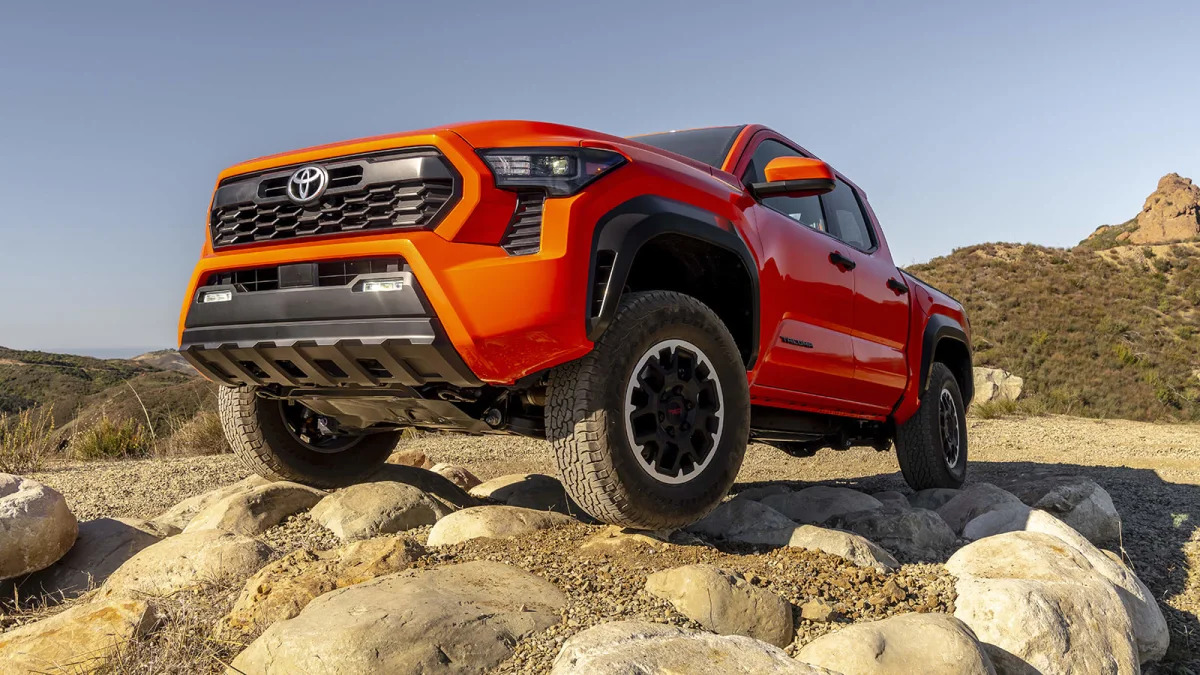

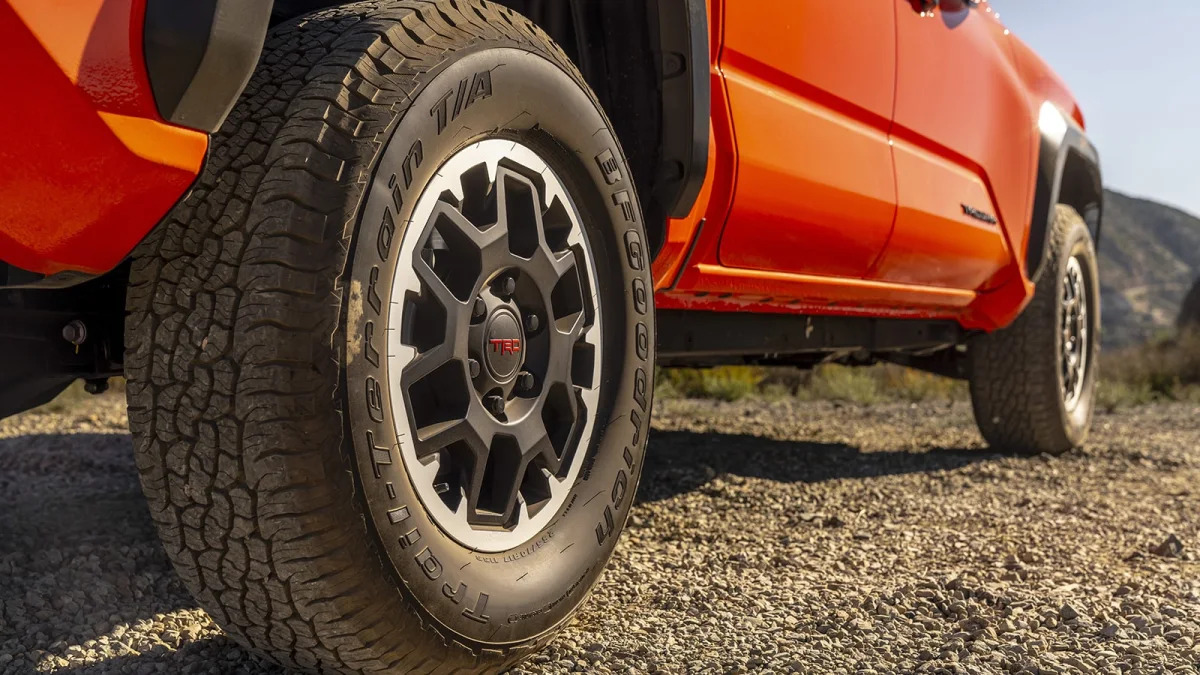
The TRD Sport and TRD Off-Road, which are crew-cab-only and therefore get the coil springs, have unique shocks. The Sport’s are sourced from the TRD parts bin, while the Off-Road gets special Bilsteins that add a second stage valve for extra damping resistance toward the end of suspension travel. Both result in a stiffer ride but a bit less body roll. Then there’s the Limited, which has electronically adjustable shocks. While the differences aren’t massive between settings, it does offer the best balance of comfort and handling, based on your preferences at any given moment.
We also got to sample the TRD Off-Road trim on some tight dirt trails with a few articulation obstacles set up. It was the only version we were able to try off-road as a showcase of the features available. So we can’t compare it directly with the other trims, but it provided a good demonstration of some of the improvements and features added to the TRD Off-Road. Most impressive was the revised CRAWL Control off-road cruise control system that operates smoother and more quietly than before, mainly reducing the awful creaking and moaning from the brakes that earlier versions of the system were known for. We were also able to try out the optional electronic disconnecting front anti-roll bar, which improves articulation when disconnected. It was easy to activate with no noticeable hang-ups.
The Off-Road comes with plenty of other upgrades such as the aforementioned Bilstein shocks, 33-inch tires on 17-inch wheels, multiple terrain modes, skid plates, an electronic locking rear differential and surround view cameras. The latter of which is particularly useful climbing steep hills with the new Tacoma’s prominent nose. And if your off-road needs are less extreme and more budget-oriented, the PreRunner remains as the rear-drive option, with a 1-inch suspension lift up front, the locking rear differential, 33-inch tires and skid plates.
If, on the other hand, your off-road needs are more extreme, some of the parts featured on the even more off-road-ready TRD Pro and Trailhunter are available as options, including ARB off-road bumpers, air compressors and tow hooks. Certain features such as the air-shock-equipped seats in the TRD Pro remain exclusive to those trims, though. And again, we didn’t get to drive those since they’re hybrid-only.
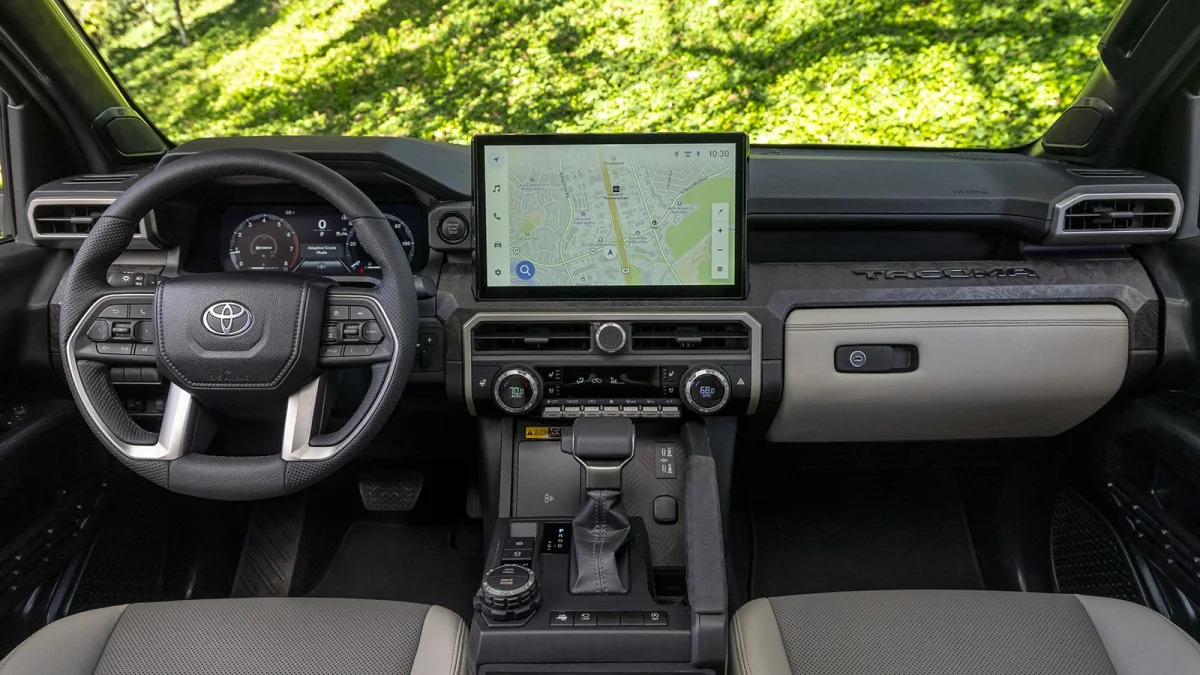
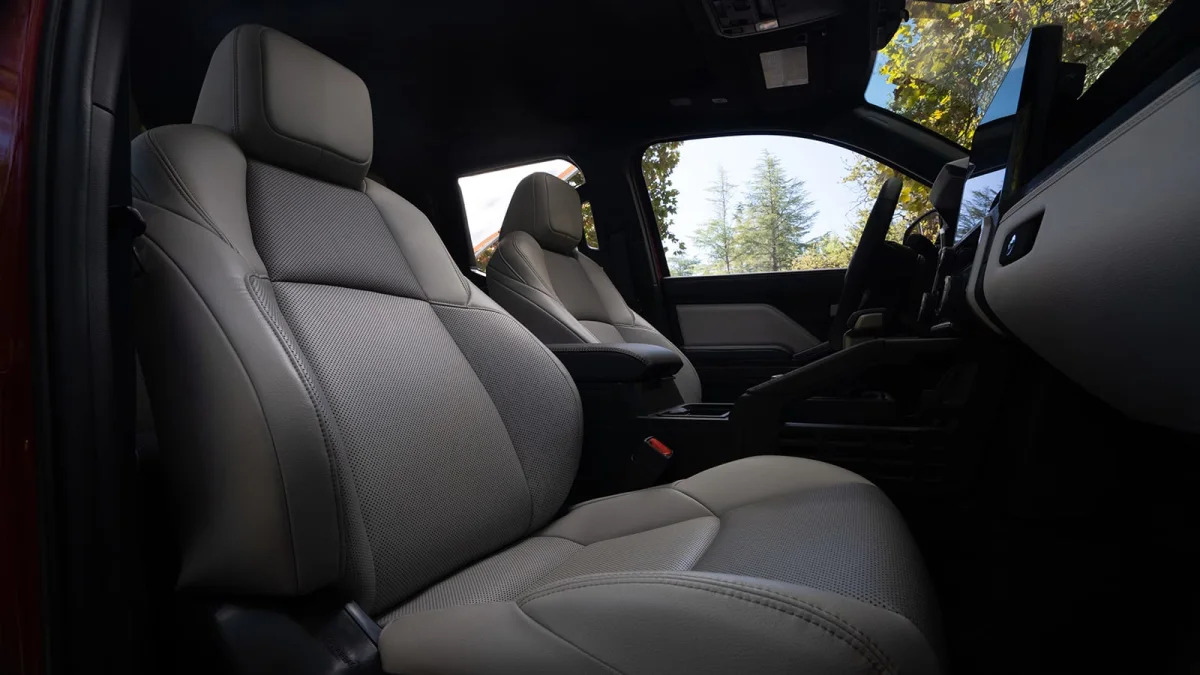
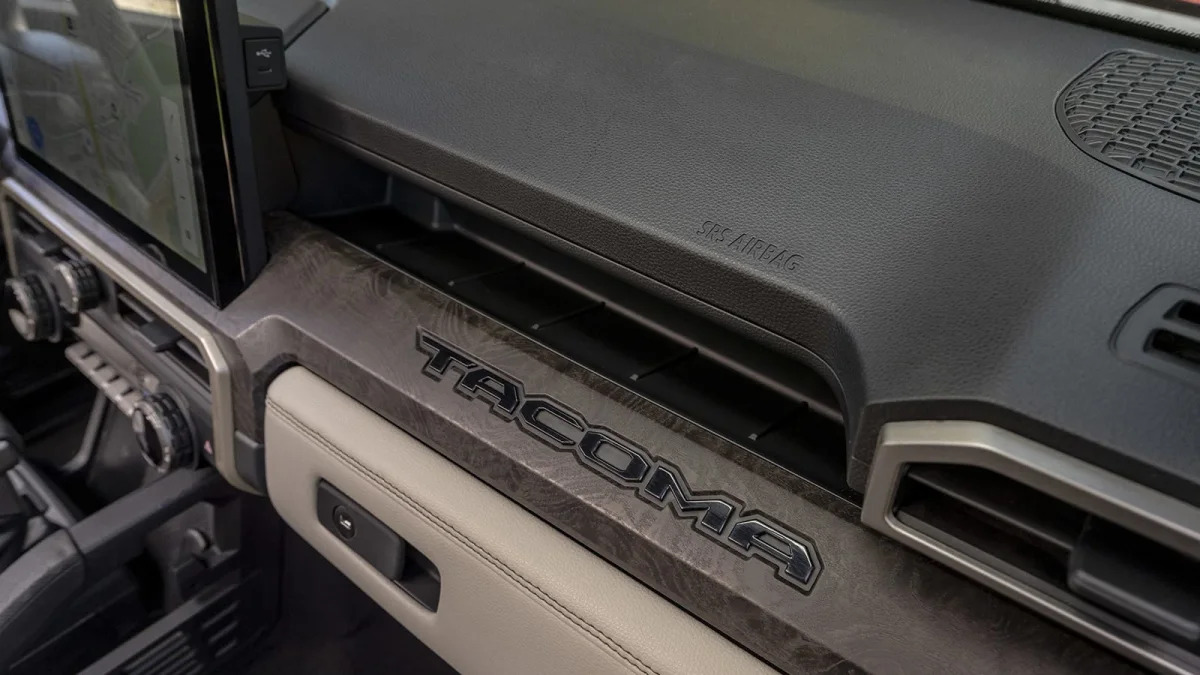
Inside, the big news is that the seating position is finally comfortable. For two decades, the Tacoma has had a bizarre, butt-on-the-floor seating position that was only slightly alleviated by power-adjustable seats. No more. The new seating position is higher, more truck-like and much better for it. Also, while the external dimensions haven’t changed by much more than an inch or two in any direction, the cabin feels quite large, particularly in shoulder and headroom. The high nose and dash contribute to the large feeling, too, making the Tacoma almost feel a size class larger than it is.
For all that’s new, the old interior’s chiseled and chunky design was obviously one of those elements that appealed to the Tacoma faithful, as designers chose to evolve the look rather than go for something radical. That said, splashes of colors available on certain versions should be a welcome addition to a truck that often goes home painted vibrant colors, especially the TRD Pro. The Limited is obviously the best-equipped and most premium in appearance, but don’t expect GMC Canyon Denali levels of luxury.
Longevity has been another Tacoma trademark, and the new interior’s plastics quality and overall fit and finish should keep that reputation intact. The various control knobs and buttons for the climate, sound and drive mode features not only exist (never a guarantee in 2023), but are large and solid pieces appropriate for a truck. All Tacomas benefit from the latest infotainment system that’s bright and straightforward, regardless of whether you get the base 8-inch screen or 14-inch screen upgrade on higher trims (both are pictured below). Both get wireless Apple CarPlay and Android Auto, but escaping from them back to the native Toyota menus remains a tap-tap-tapping source of frustration.
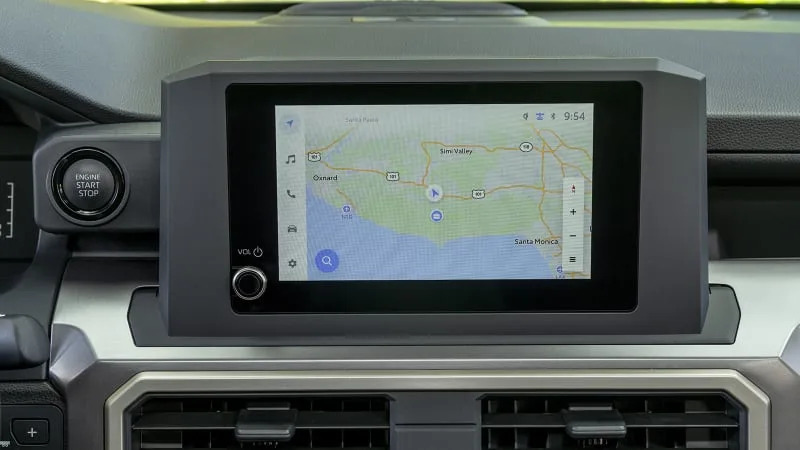
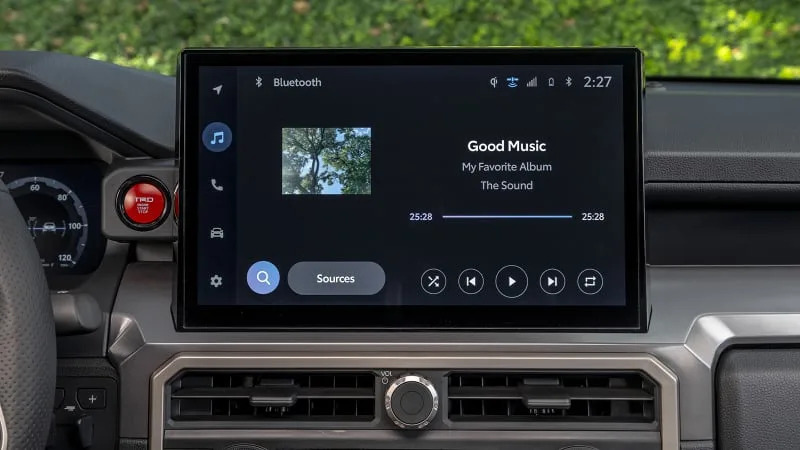
Features are yet another strong point for the Tacoma. All Tacomas get proximity entry and push-button start, LED lighting and the Toyota Safety Sense suite of driver assist systems that includes adaptive cruise control and Toyota’s new Proactive Drive Assist, which can adjust speed and steering slightly to help automatically stay a safe distance from objects even when ACC isn’t activated. As for available features, the list is quite extensive, but highlights include a JBL audio system with a removable Bluetooth speaker, all kinds of off-road armor, surround lighting that can be added to the bedsides, a head-up display, a 400-watt power outlet in the bed, a bed-mounted air compressor, surround view cameras, wireless charging, power tailgate, and much, much more, all depending on trims and packages.
All these improvements come with a higher price. The base price for the two-wheel-drive SR with the extended cab is $32,995 including the $1,495 destination charge. That’s $2,900 more than the current base SR. Adding a crew cab adds $2,200, and four-wheel drive adds $3,200. It’s also worth pointing out that the Tacoma is still a rare beast by allowing you to option the crew cab with the extended cab’s longer bed. Base prices for the other trims are below. And while the pricing has increased, it’s around $2,000 more than the cheapest Chevy Colorado, $1,500 more than a Nissan Frontier, and about $500 more than a new Ford Ranger.
- SR (2WD): $32,995
- SR5 (2WD): $37,695
- TRD PreRunner (2WD): $39,595
- TRD Sport (2WD): $40,895
- TRD Off-Road (4WD): $43,295
- Limited (4WD): $53,595
So in case you haven’t figured it out, we’re quite impressed with the Tacoma, even without trying out the flagship powertrain. It’s a serious competitor in the segment again with strong performance and efficiency, refined ride quality, and an impressive amount of features and customizations. Things just got a lot harder on the competition and Tacoma fans should rejoice that they finally have a truck good enough to match their enthusiasm.
Related video:
